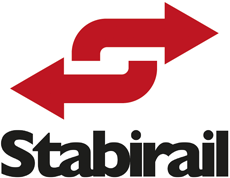Railway construction in the 21st century
First there were railway sleepers, then there was slab track, now there is Stabirails new technique to anchor rails. A true revolution in railway construction.
Ballastless track is designed so that no underlying ballast is required. The first such tracks were mountain railways with rails attached directly to the mountain bed. From the late 1960’s German, British, Swiss and Japanese railways experimented with alternatives to the traditional railway sleepers in search of solutions with higher accuracy and longevity while lowering maintenance costs.
Ballastless track systems offer the advantage of superior stability, without suffering from deformation. Especially in tunnels, high-speed railway and on lines with high frequency the ballastless track system offers many advantages. It is also used regularly in railroad tunnels and subway systems. As slab track is shallower than ballasted track, it often provides the overhead clearance needed for converting a line to overhead electrification, or for the passage of larger trains.
Since slab track is often significantly louder and causes more vibration than traditional ballasted track, a configuration called floating slab track was introduced. Although it is more expensive and requires more depth of height, it can reduce noise and vibration by around 80%. Alternatively, the rail can be supported along its length by an elastic material.
Stabirails groundbreaking technique to anchor rails
Stabirail has developed a new and groundbreaking technique for milling concrete blocks so that the rails can be assembled accurately and directly on the concrete. Our process for slab track railway construction consists of 3 alternating steps. First, entire concrete blocks are milled simultaneously with millimeter precision by a milling machine operated by a 3D system. Our milling train is capable of working on parabolic transitional curves and transitional slopes.
The milling train is immediately followed by the drilling train which makes diamond drilled holes in the concrete bed. The holes are drilled with the utmost precision. As the drilling is carried out with a water-cooled diamond drill, there is no dust formation.
The final train, used to anchor the rails, consists of both an anchoring unit and a driving unit so it can operate autonomously as well.
Stabirails new technique to anchor rails took the world of slab track railway construction by storm with its guaranteed faster construction times and more accurate design.
